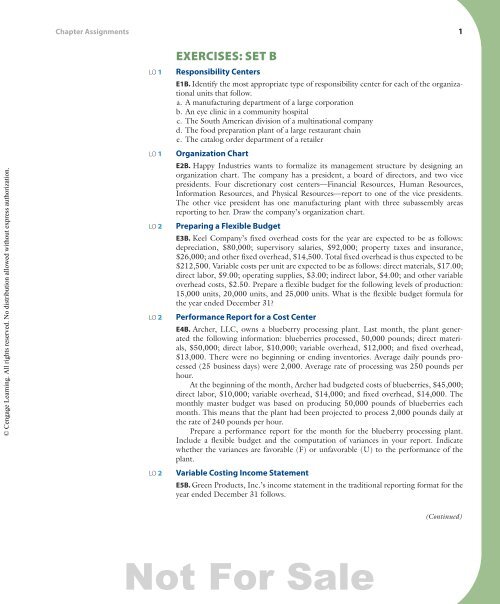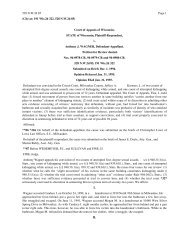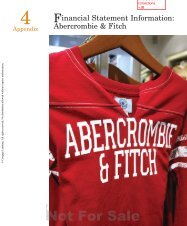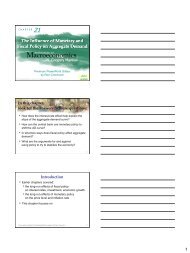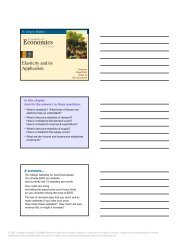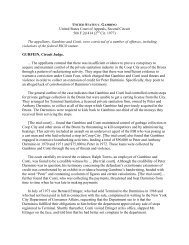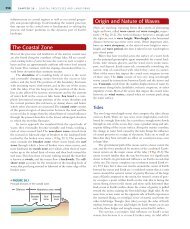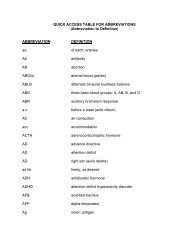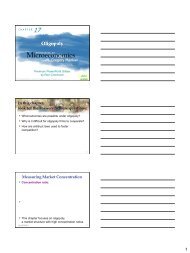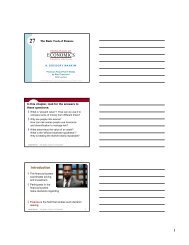Create successful ePaper yourself
Turn your PDF publications into a flip-book with our unique Google optimized e-Paper software.
© <strong>Cengage</strong> <strong>Learning</strong>. All rights reserved. No distribution allowed without express authorization.<br />
Chapter Assignments 1<br />
LO 1<br />
LO 1<br />
LO 2<br />
LO 2<br />
LO 2<br />
ExErcisEs: sEt B<br />
Responsibility Centers<br />
E1B. Identify the most appropriate type of responsibility center for each of the organizational<br />
units that follow.<br />
a. A manufacturing department of a large corporation<br />
b. An eye clinic in a community hospital<br />
c. The South American division of a multinational company<br />
d. The food preparation plant of a large restaurant chain<br />
e. The catalog order department of a retailer<br />
Organization Chart<br />
E2B. Happy Industries wants to formalize its management structure by designing an<br />
organization chart. The company has a president, a board of directors, and two vice<br />
presidents. Four discretionary cost centers—Financial Resources, Human Resources,<br />
Information Resources, and Physical Resources—report to one of the vice presidents.<br />
The other vice president has one manufacturing plant with three subassembly areas<br />
reporting to her. Draw the company’s organization chart.<br />
Preparing a Flexible Budget<br />
E3B. Keel Company’s fixed overhead costs for the year are expected to be as follows:<br />
depreciation, $80,000; supervisory salaries, $92,000; property taxes and insurance,<br />
$26,000; and other fixed overhead, $14,500. Total fixed overhead is thus expected to be<br />
$212,500. Variable costs per unit are expected to be as follows: direct materials, $17.00;<br />
direct labor, $9.00; operating supplies, $3.00; indirect labor, $4.00; and other variable<br />
overhead costs, $2.50. Prepare a flexible budget for the following levels of production:<br />
15,000 units, 20,000 units, and 25,000 units. What is the flexible budget formula for<br />
the year ended December 31?<br />
Performance Report for a Cost Center<br />
E4B. Archer, LLC, owns a blueberry processing plant. Last month, the plant generated<br />
the following information: blueberries processed, 50,000 pounds; direct materials,<br />
$50,000; direct labor, $10,000; variable overhead, $12,000; and fixed overhead,<br />
$13,000. There were no beginning or ending inventories. Average daily pounds processed<br />
(25 business days) were 2,000. Average rate of processing was 250 pounds per<br />
hour.<br />
At the beginning of the month, Archer had budgeted costs of blueberries, $45,000;<br />
direct labor, $10,000; variable overhead, $14,000; and fixed overhead, $14,000. The<br />
monthly master budget was based on producing 50,000 pounds of blueberries each<br />
month. This means that the plant had been projected to process 2,000 pounds daily at<br />
the rate of 240 pounds per hour.<br />
Prepare a performance report for the month for the blueberry processing plant.<br />
Include a flexible budget and the computation of variances in your report. Indicate<br />
whether the variances are favorable (F) or unfavorable (U) to the performance of the<br />
plant.<br />
Variable Costing Income Statement<br />
E5B. Green Products, Inc.’s income statement in the traditional reporting format for the<br />
year ended December 31 follows.<br />
<strong>Not</strong> <strong>For</strong> <strong>Sale</strong><br />
(Continued)<br />
CHE-NEEDLES_FINM-12-0107-021-WEB.indd 1 17/10/12 8:43 AM
<strong>Not</strong> <strong>For</strong> <strong>Sale</strong><br />
2 Chapter 21: Flexible Budgets and Performance Analysis<br />
LO 2<br />
LO 3<br />
LO 3<br />
Green Products, Inc.<br />
Income Statement<br />
<strong>For</strong> the Year Ended December 31<br />
<strong>Sale</strong>s $296,400<br />
Cost of goods sold 112,750<br />
Gross margin $183,650<br />
Selling expenses:<br />
Variable (69,820)<br />
Fixed (36,980)<br />
Administrative expenses (27,410)<br />
Operating income $ 49,440<br />
Total fixed manufacturing costs for the year were $16,750. All administrative expenses<br />
are considered to be fixed.<br />
Prepare an income statement for Green Products, Inc., for the year ended<br />
December 31, using the variable costing format.<br />
Traditional and Variable Costing Income Statements<br />
E6B. Interior designers often use the deluxe carpet products of Lux Mills, Inc. The Maricopa<br />
blend is the company’s top product line. In March, Lux produced and sold 174,900<br />
square yards of the Maricopa blend. Factory operating data for the month included variable<br />
cost of goods sold of $2,623,500 and fixed overhead of $346,875. Other expenses<br />
were variable selling expenses, $166,155; fixed selling expenses, $148,665; and fixed<br />
general and administrative expenses, $231,500. Total sales revenue equaled $3,935,250.<br />
All production took place in March, and there was no work in process at month end.<br />
Goods are usually shipped when completed. Prepare the March income statement for<br />
Lux Mills using:<br />
1. the traditional reporting format<br />
2. the variable costing format<br />
Investment Center Performance<br />
E7B. Accounting connEction ▶ Momence Associates is evaluating the performance<br />
of three divisions: Maple, Oaks, and Juniper. Using the data that follow, compute the<br />
return on investment and residual income for each division, compare the divisions’ performance,<br />
and comment on the factors that influenced performance.<br />
Maple Oaks Juniper<br />
<strong>Sale</strong>s $100,000 $100,000 $100,000<br />
Operating income $10,000 $10,000 $20,000<br />
Assets invested $25,000 $12,500 $25,000<br />
Desired ROI 40% 40% 40%<br />
Economic Value Added<br />
E8B. Accounting connEction ▶ Leesburg, LLP, is evaluating the performance of<br />
three divisions: Lake, Sumter, and Poe. Using the data that follow, compute the economic<br />
value added by each division, and comment on each division’s performance.<br />
Lake Sumter Poe<br />
<strong>Sale</strong>s $100,000 $100,000 $100,000<br />
After-tax operating income $10,000 $10,000 $20,000<br />
Total assets $25,000 $12,500 $25,000<br />
Current liabilities $5,000 $5,000 $5,000<br />
Cost of capital 15% 15% 15%<br />
CHE-NEEDLES_FINM-12-0107-021-WEB.indd 2 17/10/12 8:43 AM<br />
© <strong>Cengage</strong> <strong>Learning</strong>. All rights reserved. No distribution allowed without express authorization.
© <strong>Cengage</strong> <strong>Learning</strong>. All rights reserved. No distribution allowed without express authorization.<br />
Chapter Assignments 3<br />
LO 3<br />
LO 4<br />
LO 4<br />
LO 4<br />
Return on Investment and Economic Value Added<br />
E9B. Micanopy Company makes replicas of Indian artifacts. The balance sheet for the<br />
Arrowhead Division showed that the company had invested assets of $300,000 at the<br />
beginning of the year and $500,000 at the end of the year. During the year, the division’s<br />
operating income was $80,000 on sales of $1,200,000.<br />
1. Compute the division’s residual income if the desired ROI is 20 percent.<br />
2. Compute the following performance measures for the division: (a) profit margin,<br />
(b) asset turnover, and (c) return on investment. (Round profit margin percentage<br />
to two decimal places.)<br />
3. Recompute the division’s ROI under each of the following independent assumptions:<br />
a. <strong>Sale</strong>s decrease from $1,200,000 to $1,000,000, causing operating income to fall<br />
from $80,000 to $50,000.<br />
b. Invested assets at the beginning of the year are reduced from $300,000 to<br />
$100,000. (Round to two decimal places.)<br />
c. Operating expenses are reduced, causing operating income to rise from $80,000<br />
to $90,000.<br />
4. Compute the company’s EVA if total corporate assets are $6,000,000, current<br />
liabilities are $800,000, after-tax operating income is $750,000, and the cost of<br />
capital is 12 percent.<br />
Balanced Scorecard<br />
E10B. BusinEss ApplicAtion ▶ Biggs Industries is considering adopting the balanced<br />
scorecard and has compiled the following list of possible performance measures. Select<br />
the balanced scorecard perspective that best matches each performance measure.<br />
Balanced Scorecard Perspective Performance Measure<br />
a. Financial (investor) 1. Residual income<br />
b. <strong>Learning</strong> and growth (employee) 2. Customer satisfaction rating<br />
c. Internal business processes 3. Employee absentee rate<br />
d. Customer 4. Growth in profits<br />
5. On-time deliveries<br />
6. Manufacturing processing time<br />
Performance Measures<br />
E11B. BusinEss ApplicAtion ▶ Sam Yu wants to measure customer satisfaction within<br />
his region. Link an appropriate performance measure with each balanced scorecard<br />
perspective.<br />
Customer Satisfaction Possible Performance Measures<br />
a. Financial (investor) 1. Number of staff promotions<br />
b. <strong>Learning</strong> and growth (employee) 2. Number of repeat customers<br />
c. Internal business processes 3. Number of process improvements<br />
d. Customer 4. Percentage sales increase over last period<br />
The Balanced Scorecard<br />
E12B. BusinEss ApplicAtion ▶ Tim’s Bargain Basement sells used goods at very low<br />
prices. Tim has developed the following business objectives:<br />
1. To buy only the inventory that sells<br />
2. To have repeat customers<br />
3. To be profitable and grow<br />
4. To keep employee turnover low<br />
<strong>Not</strong> <strong>For</strong> <strong>Sale</strong><br />
(Continued)<br />
CHE-NEEDLES_FINM-12-0107-021-WEB.indd 3 17/10/12 8:43 AM
<strong>Not</strong> <strong>For</strong> <strong>Sale</strong><br />
4 Chapter 21: Flexible Budgets and Performance Analysis<br />
LO 4<br />
LO 5<br />
LO 5<br />
Tim also developed the following performance measures:<br />
5. Growth in revenues and net income per quarter<br />
6. Average unsold goods at the end of the business day as a percentage of the total<br />
goods purchased that day<br />
7. Number of unemployment claims<br />
8. Percentage of repeat customers<br />
Match each of these objectives and performance measures with the four perspectives<br />
of the balanced scorecard: financial perspective, learning and growth perspective,<br />
internal business processes perspective, and customer perspective.<br />
The Balanced Scorecard<br />
E13B. BusinEss ApplicAtion ▶ Your college’s overall goal is to add value to the communities<br />
it serves. In light of that goal, match each of the stakeholders’ perspectives that<br />
follow with the appropriate objective.<br />
Perspective Objective<br />
a. Financial (investor) 1. Adding value means that the faculty engages in<br />
meaningful teaching and research.<br />
b. <strong>Learning</strong> and growth (employee) 2. Adding value means that students receive their<br />
degrees in four years.<br />
c. Internal business processes 3. Adding value means that the college has<br />
winning sports teams.<br />
d. Customer 4. Adding value means that fund-raising<br />
campaigns are successful.<br />
Performance Incentives<br />
E14B. BusinEss ApplicAtion ▶ Dynamic Consulting is advising Solid Industries on<br />
the short-term and long-term effectiveness of cash bonuses, awards, profit sharing, and<br />
stock as performance incentives. Prepare a chart identifying the effectiveness of each<br />
incentive as either long-term or short-term or both.<br />
Goal Congruence<br />
E15B. BusinEss ApplicAtion ▶ Serious Toys, Inc., has adopted the balanced scorecard<br />
to motivate its managers to work toward the companywide goal of leading its industry<br />
in innovation. Identify the four stakeholder perspectives that would link to the following<br />
objectives, measures, and targets:<br />
Perspective Objective Measure Target<br />
Profitable new<br />
products<br />
Successful product<br />
introductions<br />
Agile production<br />
processes<br />
Workforce with<br />
cutting-edge skills<br />
New-product RI New-product RI of at least<br />
$100,000<br />
New-product market share Capture 75 percent of<br />
new-product market<br />
within 6 months<br />
Time to market (the time<br />
between a product idea<br />
and its first sales)<br />
Percentage of employees<br />
cross-trained on<br />
work-group tasks<br />
Time to market less than<br />
6 months for 80 percent of<br />
product introductions<br />
90 percent of work group<br />
cross-trained on new tasks<br />
within 10 days<br />
CHE-NEEDLES_FINM-12-0107-021-WEB.indd 4 17/10/12 8:43 AM<br />
© <strong>Cengage</strong> <strong>Learning</strong>. All rights reserved. No distribution allowed without express authorization.


